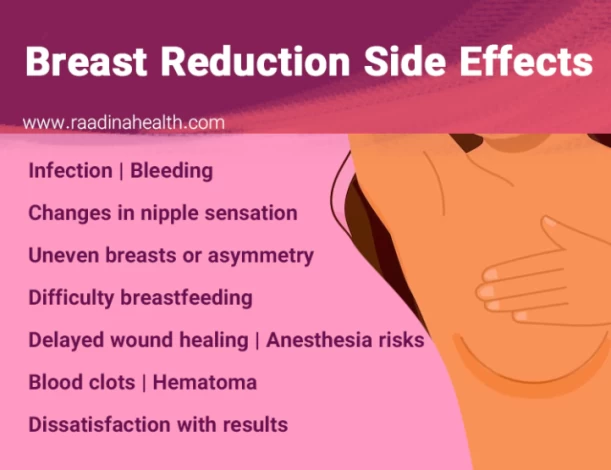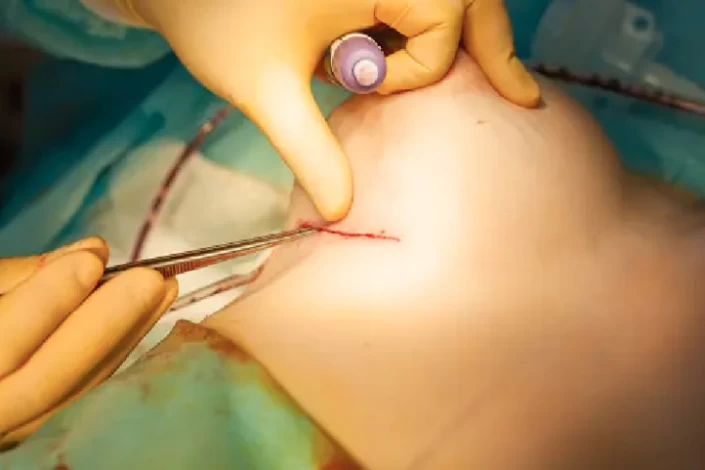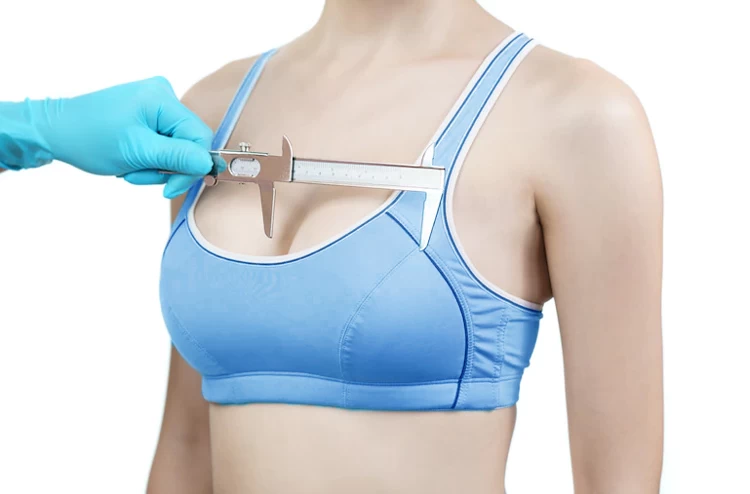Does Breast Reduction Mammoplasty Have Serious Side Effects?
Body Plastic Surgery
Like any surgical procedure, breast reduction surgery or reduction mammoplasty carries certain risks. The breast reduction risks can vary depending on the patient's overall health, age, and the specific technique used during the surgery.
It is essential to discuss breast reduction side effects with a qualified plastic surgeon before deciding to undergo the surgery. The surgeon will evaluate the individual's specific situation and provide personalized advice regarding the involved risks.
What are the Risks of Breast Reduction Surgery?
Scarring is an expected complication of breast reduction surgery that will fade over time but never disappear completely. These scars can worsen if patients lift heavy objects soon after the surgery.
Other potential breast reduction side effects may include:
- Infection
- Bleeding
- Changes in nipple sensation
- Uneven breasts or asymmetry
- Difficulty breastfeeding
- Delayed wound healing
- Anesthesia risks
- Blood clots
- Hematoma
- Dissatisfaction with results

Infection
Although rare, there is a risk of developing an infection at the surgical site after breast reduction surgery, which may require antibiotics or further treatment. Signs and symptoms of an infection after breast reduction surgery may include increased pain, redness and warmth, drainage (Pus or fluid may drain from the incisions), fever or chills, and persistent or worsening symptoms. It is crucial to address breast reduction signs of infection promptly to prevent further complications and promote proper healing.
Pain
It is common to feel temporary pain, discomfort, and soreness in the breasts and surrounding areas for several days after the surgery, which can be managed with prescribed pain medications.
In rare cases, patients may experience long-term pain after breast reduction surgery. This can be caused by various factors, including nerve damage, scar tissue formation, or underlying medical conditions. In this case, patients should consult with their surgeon for further evaluation and management. They may recommend additional treatments or therapies to help alleviate the pain and improve the patient's comfort.
Bleeding
Excessive bleeding during or after the breast reduction surgery is possible, which may necessitate further intervention, such as draining excess blood or performing additional surgery to control bleeding. To minimize the risk of excessive bleeding, patients must follow all pre-operative instructions provided by their surgeon, such as avoiding certain medications that can increase bleeding risk.
Changes in nipple sensation
Temporary or permanent changes in nipple sensation, including numbness or increased sensitivity, may occur after breast reduction surgery. The cause of this complication is that the surgery involves repositioning or resizing the nipples, which can affect the nerves in the area.
Uneven breasts or asymmetry
Despite efforts to achieve symmetry, there is a possibility of unevenness between the breasts in terms of size, shape, or position. In some cases, revision surgery may be recommended to adjust further the size, shape, or position of the breasts. While some degree of asymmetry is normal and expected, significant breast asymmetry may require further revision surgery to correct. However, it is important to have realistic expectations and understand that achieving perfect symmetry may not always be possible.
Difficulty breastfeeding
Breast reduction surgery may sometimes affect milk production and the ability to breastfeed, as the surgery may involve removing or repositioning the milk ducts and glands. Therefore, patients who intend to get pregnant in the future must discuss this concern with the surgeon beforehand.
Delayed wound healing
Sometimes, delayed wound healing or poor wound closure may occur after breast reduction surgery, leading to complications such as infection or increased scarring. Treatment options for delayed wound healing can vary depending on the severity and cause of the problem. They may include wound care techniques such as regular cleaning and dressing changes, antibiotic therapy for infection, and, in some cases, surgical intervention to remove necrotic tissue or close the wounds.

Anesthesia risks
General anesthesia carries risks, including allergic reactions, breathing difficulties, or adverse reactions to used medications during the procedure.
Blood clots
Like all surgical procedures, there is a small risk of developing blood clots in the legs (deep vein thrombosis) or lungs (pulmonary embolism) after breast reduction surgery. Patients who take oral contraceptive pills or hormone replacement therapy and smoke are at a higher risk of blood clots.
Hematoma
Hematoma is a potential complication that can occur after breast reduction surgery. It refers to the accumulation of blood outside blood vessels, typically in a pocket or cavity formed by the surgical procedure. Hematoma is a potential complication that can occur after breast reduction surgery. It refers to the accumulation of blood outside blood vessels, typically in a pocket or cavity formed by the surgical procedure. Hematomas can vary in size and severity, ranging from small and inconsequential to more extensive and problematic.
Signs and symptoms of a hematoma after breast reduction surgery may include swelling, bruising, discoloration, tenderness, and palpable mass.
Dissatisfaction with results
While breast reduction surgery aims to improve body image and alleviate physical discomfort, there is a possibility that a patient may not be satisfied with the aesthetic outcome or experience unexpected changes.
Contact us for a free initial consultation about breast reduction surgery.
WhatsAppTelegramFacebookEmailHow to Minimize the Risk of Breast Reduction Complications?
Every surgical procedure carries some inherent risks. Patients must discuss the potential complications with the surgeon and weigh them against the benefits of breast reduction surgery before making a decision.
To reduce the risk of breast reduction complications, it is important to follow the below guidelines:
- Choose a qualified and experienced surgeon: Ensure that your surgeon is board-certified and has extensive experience in performing breast reduction surgeries. Research their credentials, read reviews, and ask for before and after photos of previous patients.
- Communicate openly with your surgeon: During your consultation, discuss your expectations, concerns, and any medical conditions or medications you are currently taking. This will help your surgeon determine if you are a suitable candidate for the procedure and develop a personalized surgical plan.
- Undergo a thorough medical evaluation: Before the surgery, your surgeon will conduct a comprehensive medical evaluation to assess your overall health and identify any potential risk factors. This may involve blood tests, mammograms, and other diagnostic tests.
- Follow pre-operative instructions: Your surgeon will provide specific instructions to follow before the surgery. This may include avoiding certain medications, quitting smoking, and maintaining a healthy lifestyle.
- Be honest about your medical history: Inform your surgeon about any previous surgeries, medical conditions, or allergies you have had. This information is crucial for your surgeon to make informed decisions during the procedure and minimize the risk of complications.
- Follow post-operative care instructions: After the surgery, your surgeon will provide detailed instructions on how to care for your incisions, manage pain, and minimize the risk of infection. It is important to follow these instructions diligently to ensure proper healing and reduce the risk of complications.
- Attend all follow-up appointments: Regular follow-up appointments are essential to monitor your healing progress and address any concerns or complications that may arise. Attend all scheduled appointments and communicate any changes or issues you experience.
- Maintain a healthy lifestyle: Leading a healthy lifestyle can contribute to better surgical outcomes and reduce the risk of complications. This includes maintaining a balanced diet, engaging in regular exercise (as advised by your surgeon), and avoiding smoking and excessive alcohol consumption.
The bottom line
Breast reduction surgery is a relatively safe procedure for reducing the size of breasts or chest tissue. However, like most surgical procedures, there are potential risks and side effects.
If you're considering breast reduction surgery, contact our team at Raadina Health to set up an online consultation now! We guarantee that you will have a completely safe reduction mammoplasty in Iran.
FAQs About Breast Reduction Side Effects
1) What are the downsides and disadvantages of breast reduction?
While breast reduction surgery can be highly effective in reducing breast size and improving symptoms like back pain, some patients may not be satisfied with the results of the procedure. This surgery typically involves incisions that can leave scars on the breasts. While these scars may fade over time, they may still be visible and can be a concern for some patients.
Breast reduction surgery can sometimes result in changes in nipple and breast sensation, including numbness or hypersensitivity. It may make it more difficult or impossible to breastfeed in the future. Also, as with any surgery, there is a risk of infection following breast reduction surgery.
2) When does breast reduction go wrong? What are the Signs?
When breast reduction surgery fails, it can result in a range of complications and negative outcomes. In some cases, the scars from breast reduction surgery may be more extensive than expected or may not heal properly, resulting in unsightly or uncomfortable scars.
The failed surgery may result in visible uneven or asymmetrical breasts, which can be a source of dissatisfaction for patients. Bad breast reduction surgery may also result in a loss of sensation in the nipples, which can affect sexual function and overall quality of life. This surgery can also cause fat tissue to die off, resulting in hard lumps or masses that may require further treatment.
3) May my breasts feel different after reduction?
Yes, breasts may feel different after reduction surgery. The size and shape of the breasts will change, and some women may experience a decrease in sensitivity or numbness in the nipples or breast tissue.
However, many women report feeling more comfortable and confident after the surgery, as they are able to engage in physical activities without discomfort or self-consciousness. It is important to discuss any concerns or questions about how your breasts may feel after reduction surgery with your surgeon.
4) How should I care for my chest to prevent scarring after reduction mammoplasty?
You can prevent scarring after your breast reduction by following your surgeon's post-operative instructions carefully, including any medication or wound care recommendations.
You should keep the incision sites clean and dry and avoid exposing them to sunlight or tanning beds. Wearing a supportive bra and Massaging the scars gently with a moisturizing cream or oil can also help reduce swelling and promote healing.
5) Is a breast reduction procedure painful?
Breast reduction surgery is a major surgical procedure that involves incisions and tissue removal, so some discomfort and pain are to be expected. Your surgeon will provide you with pain medication and instructions on how to manage any discomfort during your recovery. It is important to follow your surgeon's post-operative instructions carefully to minimize pain and promote healing.















User
-Your insightful blog post was a captivating read, providing valuable information.
Habib Ebrahimi
-Hello dear friend,
Thanks for your positive feedback.